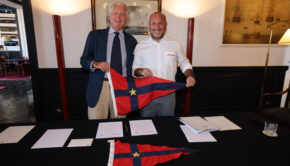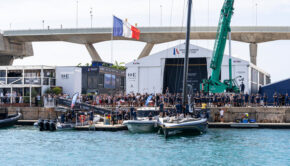8 Days to the LVC
Published on June 30th, 2013
By Dean Barker, Skipper ETNZ (from Barker’s blog dated June 30, 2013)
Well, again a long time between posts. It would be fair to say though there has been a fair amount happening in the last couple of months.
I have been in San Fran now for about 6 weeks. It has been great to get settled up here and get some good quality sailing on San Fran Bay. It certainly has not disappointed as a venue with great sailing breeze and a dramatic sailing venue between the city front and Alcatraz Island.
I arrived in SF 2 days after the tragic Artemis accident where Andrew Simpson lost his life. I think most people were still heavily in shock and it certainly had not sunk in at what had transpired. It just did not seem conceivable that Bart had gone.
A Safety Review Committee was immediately convened to see what if any safety measures could be put in place to make the boats safer for the crews and the racing would be in sensible wind limits. It quickly became clear that the Review Committee was not empowered to enforce their recommendations having interviewed up to 30 members from the different AC teams. However Iain Murray, the Regatta Director, took the Review Committee’s findings and released his own 37 Safety Recommendations which he imposed on the Teams.
We are 100% in support of the Safety Recommendations which are in fact that. Nearly every single one of the 37 did in fact increase the safety of the crew and racing conditions. However within the Safety Recommendations there are two which change the AC72 Class Rule and have absolutely no justification in making the boats or racing safer.
There has been a lot of discussion in the media centred mainly around the issue of the rudder and rudder elevators. In the AC72 Class Rule you are allowed to build rudder elevators which are not allowed to exceed the maximum beam of the yacht, nor extend aft of one metre forward of the stern plane of the yacht. The AC72 class was never envisioned to fully foil, however through 1000’s of hours of design and testing we made a decision that our first AC72 would be a fully foiling yacht.
To do this we needed to increase the engineering of a number of components of the boat to accept the extra loading as a boat comes clear of the water. We also took design compromises to allow us to build a boat which would foil in a stable and reliable fashion. The compromise was often straight line speed, but a compromise we felt necessary for safety and the ability to push the boat hard.
The Safety Recommendations included a number of points regarding the rudders and rudder elevators. The main ones were imposing a minimum rudder length of 2.1m, introducing a minimum elevator area of 0.32m2, removing the maximum beam rule which effectively allows the elevators to extend outside the beam of the boat, and insisting the elevators must be symmetrical in plan view.
We agree with imposing a minimum length of rudder even though this made one of our set of rudders illegal. We also thought it was sensible to impose a minimum elevator area. However we are completely opposed to allowing elevators to extend outside of maximum beam and having to be symmetric.
Allowing the rudder elevators to extend outside of max beam is incredibly dangerous and introduces serious risk for the crew. If a crew member was to fall overboard from either hull while the boat is foiling there is a much greater chance they would be struck by the longer elevator and this would lead to a serious injury. As the rule is currently written, with the elevators limited to maximum beam, the chance of injury is greatly reduced.
The second point we are completely opposed to is having to make the elevators symmetric in plan view. We took a clear compromise when designing our boat to position our rudder bearings to allow us to build an elevator to the size we felt necessary. With the existing class rule it is possible to build an elevator well in excess of the imposed minimum area. From day one of sailing our AC72 yachts we have sailed with asymmetric elevators. We have now done well over 60 days with these elevators and have never had a structural issue with either rudders or elevators. It is completely unnecessary to impose the requirement for the elevators to be symmetric in plan form. There is no logical argument to say that asymmetric elevators are not safe. We have sailed with our current elevators for the bulk of the sailing we have done.
With the Regatta Director trying to suggest that these are not safe, and having to build brand new, untested elevators at this late stage only introduces new risk. As a twist the Regatta Director has now said that it is fine to either use symmetric elevators which extend outside of the maximum beam, or use asymmetric elevators. However if you choose to use asymmetric elevators these now have to pass an engineering load case, although symmetric do not. We comply with this last minute regulation, but this is the only load case ever asked for, and nothing like this exists in the Class Rule. In my opinion there are other load cases which have a much greater bearing on safety, but these have never been questioned.
If the Regatta Director wanted to help with the understanding of safety, I think all teams could benefit with a report on what led to the capsize of Artemis. There has been a lot of speculation as to the cause but there has never been a report so that the other teams can understand potential issues. Really it can only be a crew error which resulted in the capsize, or a structural failure, and understanding this would help all teams.
The AC72 Class Rule is not an unsafe rule. There are choices each team needs to make and these are a balance between performance and safety. You can make an incredibly safe AC72 which would probably have a compromise on performance. So the rule encourages a certain amount of risk vs reward. The boats are incredibly powerful, complex and amazingly fast. The faster you go the more risk there is. This is the same as with motor racing. Imposing real safety measures have greatly reduced the chances of further crew injuries. However there is a line which needs to be drawn between safety improvements and class rule changes which have no bearing on safety.
The great news is we get to go racing on the 7th July. This is the first race of the Louis Vuitton Challenger Selection Series. We race Luna Rossa in this race and will race them five times during July. We will also compete on the Artemis race days, although it is not clear when they will make it to the start line. We have a busy week ahead with final preparations, but looking forward to the racing getting underway. View blog








 We’ll keep your information safe.
We’ll keep your information safe.